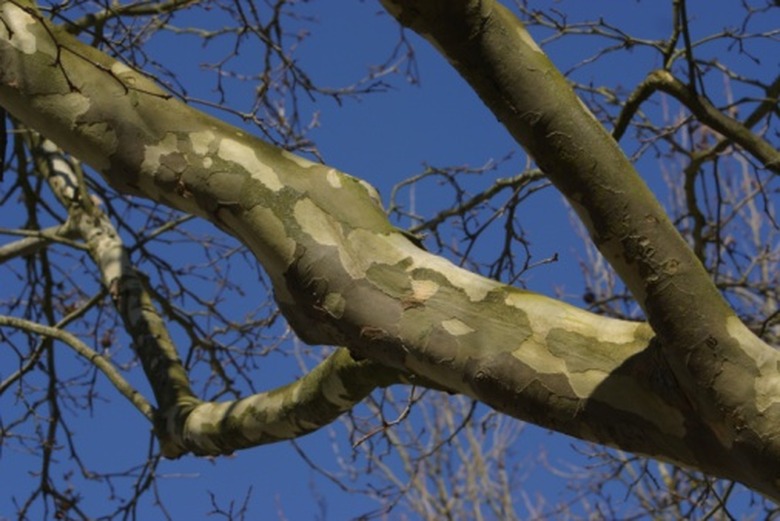How To Tell If A Sycamore Tree Is Dying
An American sycamore (Platanus occidentalis) provides shade and beauty in large backyards for up to 250 years. Large and stately, the sycamore grows fast and can exceed 100 feet. Its massive trunk carries branches that can spread as wide as the tree is tall. In winter, the bark peels back, revealing the inner mottled layers in different shades. Sycamores are subject to several serious conditions that can prove fatal, so it pays to examine your tree regularly and take preventive action where possible.
Step 1
Inspect your sycamore in the spring. Both flowers and leaves appear on sycamores as early as March. The bright green leaves look like stars, while the flowers are both staminate and pistulate, in tight, ball-shaped clusters. If you see no signs of leaf growth by mid-April, your tree may be dead.
Step 2
Cut into the bark of a branch with a small knife. If the inner bark layer is green, the sycamore is alive. Brown inner bark indicates that the branch is dead. If many branches are dead, the tree is likely dying.
Step 3
Inspect the leaves in late summer for irregular scorch patterns between leaf veins. Red borders separate these brown patches from the rest of the leaf. Scorched leaves curl up. These are symptoms of Bacterial Leaf Scorch. The disease spreads from leaf to leaf, killing entire limbs over time and threatening the life of the tree. No cure exists for this disease, although you can prolong the life of the tree by pruning and burning affected limbs and providing water and fertilizer regularly.
Step 4
Examine the new leaves on a weekly basis. If young leaves turn brown and wilt, your tree suffers from either frost damage or sycamore antracnose. Frost damage is nothing to worry about; it turns the entire leaf brown, but the problem passes as new leaves form. Sycamore antracnose is more serious. This fungal disease turns the leaves brown along the veins. It also kills twigs and, if severe, entire branches. Although anthracnose does not typically kill sycamores, according to Iowa State University horticulturists, it deforms the trees and occasionally proves fatal. Fungicide protects your sycamore from anthracnose.
Step 5
Look for patches of powdery white matter on sycamore leaves or branches, an indication that your sycamore has powdery mildew disease. This is most common in trees growing in full shade near water. Infected leaves distort, yellow and fall. The disease stunts new growth as well. Powdery mildew disease will not kill your tree. If the tree is still small enough to spray, ask your nursery for an appropriate fungicide.
Tip
Dead sycamores often regenerate from tree stumps. Alternatively, you can plant a branch cutting in autumn and have a new tree by spring.
Warning
Sycamores are not the perfect backyard tree for everyone. Their large leaves take years to decompose and the prickly fruit casing hurts bare feet.
